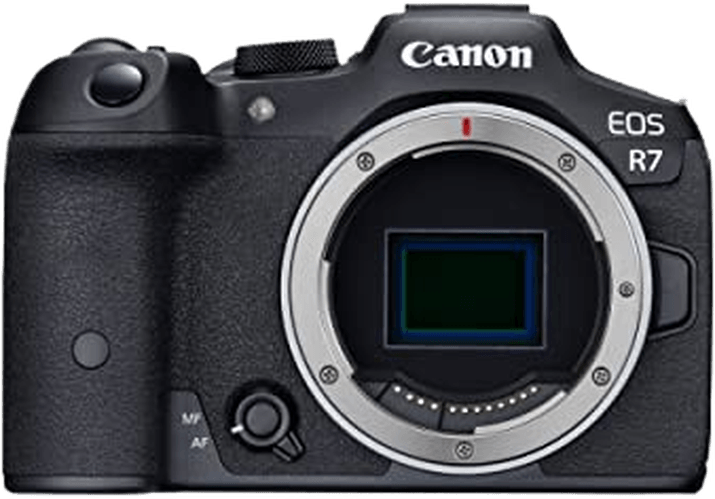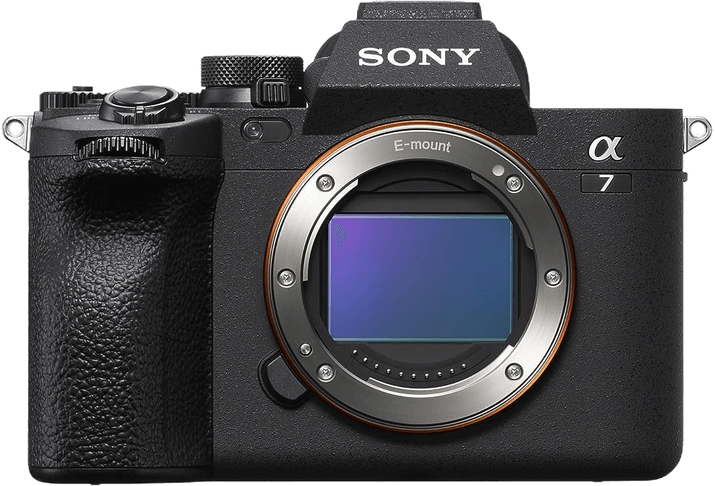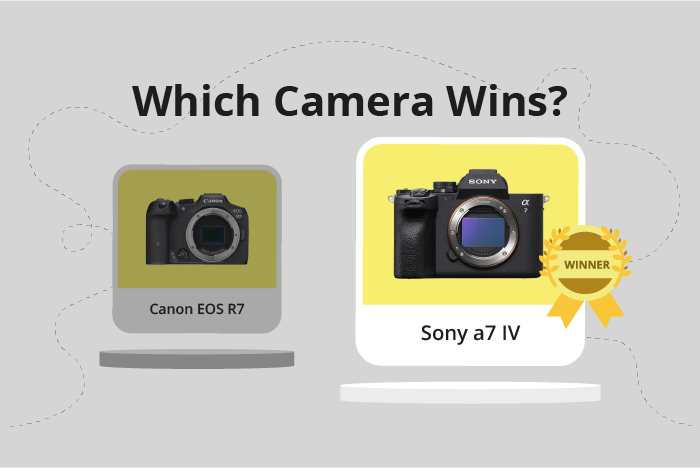Canon EOS R7 vs Sony a7 IV Comparison
Canon EOS R7

Sony a7 IV

The Sony a7 IV narrowly wins over the Canon EOS R7 with a score of 84/100 compared to 83/100. Both cameras are mirrorless and share similar dimensions, with the Canon EOS R7 measuring 132 x 90 x 92mm and the Sony a7 IV at 131 x 96 x 80mm. The Canon EOS R7 is lighter, weighing 612g, while the Sony a7 IV weighs 659g.
The Canon EOS R7 has its advantages, such as a lower launch price of $1500 compared to the Sony a7 IV’s $2499. Its lighter weight also makes it more portable and comfortable to use. On the other hand, the Sony a7 IV’s higher score shows that it performs better in certain aspects, justifying its higher price.
Both cameras have their merits, but the Sony a7 IV takes the lead by a slim margin. The Canon EOS R7 is a more budget-friendly and lighter option, while the Sony a7 IV offers better performance at a higher cost. Ultimately, the choice depends on the user’s priorities and budget.
Canon EOS R7 vs Sony a7 IV Overview and Optics
The Sony a7 IV wins the optics comparison with a score of 85/100, while the Canon EOS R7 scores 82/100. Both cameras have 33-megapixel CMOS sensors, image stabilization, and similar DXOMARK sensor scores of 97. They also share the same shooting speed and lens mounts, with the Canon using the RF mount and the Sony using the FE mount.
The Sony a7 IV outperforms the Canon EOS R7 in some key areas. Its full-frame sensor size offers better low-light performance and overall image quality compared to the Canon’s APS-C sensor. Additionally, the Sony a7 IV’s Bionz XR processor provides faster processing speeds, which contributes to improved performance in various shooting scenarios.
On the other hand, the Canon EOS R7 has a higher shooting speed of 15 frames per second, compared to the Sony a7 IV’s 10 frames per second. This advantage makes the Canon EOS R7 better suited for action and sports photography, where capturing fast-moving subjects is crucial.
In terms of optics, the Sony a7 IV is the superior choice due to its full-frame sensor and faster processor. However, the Canon EOS R7’s higher shooting speed may appeal to photographers who prioritize capturing fast action. Both cameras offer excellent optics performance, but the Sony a7 IV’s advantages in sensor size and processing speed ultimately give it the edge in this comparison.
Canon EOS R7 vs Sony a7 IV Video Performance
The Canon EOS R7 and the Sony a7 IV both achieve a video score of 91/100, indicating their equal capabilities in this aspect. Both cameras share key specifications, such as a maximum video resolution of 4K, dimensions of 3840 x 2160, and a maximum frame rate of 120fps. Additionally, both cameras feature built-in time-lapse functionality.
The Canon EOS R7 excels in its user-friendly interface and color science, providing users with a straightforward experience and natural-looking color reproduction. This advantage allows EOS R7 users to focus on capturing creative and engaging video content without the need for extensive post-production work.
On the other hand, the Sony a7 IV boasts superior low-light performance and advanced autofocus capabilities. These features enable videographers to capture stunning footage in challenging lighting conditions and maintain sharp focus on their subjects. Consequently, the a7 IV is a valuable tool for filmmakers seeking to push the boundaries of their craft.
Despite their equal video scores, the Canon EOS R7 and Sony a7 IV each offer unique advantages tailored to different videography needs. The EOS R7 is ideal for those seeking a user-friendly experience and natural color reproduction, while the a7 IV is better suited for filmmakers requiring advanced low-light performance and autofocus capabilities. Ultimately, the choice between these cameras depends on the individual needs and preferences of the videographer.
Canon EOS R7 vs Sony a7 IV Features and Benefits
The Canon EOS R7 wins the features comparison with a score of 85/100, while the Sony a7 IV scores slightly lower at 83/100. Both cameras share several common specifications, including a 3-inch screen size, touchscreen capabilities, flip screen, absence of GPS, and the presence of WIFI and Bluetooth connectivity.
The Canon EOS R7 outperforms the Sony a7 IV in screen resolution, offering 1,620,000 dots compared to the 1,040,000 dots on the Sony a7 IV. This higher resolution provides a clearer and more detailed display, allowing for better image review and menu navigation.
On the other hand, the Sony a7 IV has a few advantages over the Canon EOS R7, though they do not outweigh the benefits of the higher screen resolution. These advantages may include better battery life, a more extensive lens selection, or other features not mentioned in this comparison.
To conclude, the Canon EOS R7 is the winner in this features comparison due to its higher resolution screen. The Sony a7 IV, while slightly behind in this aspect, may still have other advantages to consider. Ultimately, the choice between these two cameras depends on individual preferences and priorities when it comes to features and performance.
Canon EOS R7 vs Sony a7 IV Storage and Battery
The Canon EOS R7 wins in the storage and battery category with a score of 79/100, while the Sony a7 IV scores 76/100. Both cameras have two memory card slots and USB charging capabilities. The Canon EOS R7 accepts SD, SDHC, and SDXC cards with UHS-II compatibility, while the Sony a7 IV accepts CFexpress Type A and SD cards with UHS-II compatibility.
The EOS R7 outperforms the a7 IV in battery life, offering 660 shots with its LP-E6NH battery, compared to the a7 IV’s 580 shots with the NP-FZ100 battery. This longer battery life makes the Canon EOS R7 more suitable for extended shooting sessions.
However, the Sony a7 IV has the advantage of supporting CFexpress Type A memory cards, which provide faster read and write speeds than SD cards. This can be beneficial for photographers who need to quickly transfer large files or shoot high-speed bursts.
Taking these factors into account, the Canon EOS R7 offers better battery life, making it more reliable for longer shoots. On the other hand, the Sony a7 IV provides faster storage options through its support for CFexpress Type A cards, which may be important for certain users.
Alternatives to the Canon EOS R7 and Sony a7 IV
Are you still undecided about which camera is right for you? Have a look at these popular comparisons that feature the Canon EOS R7 or the Sony a7 IV:

